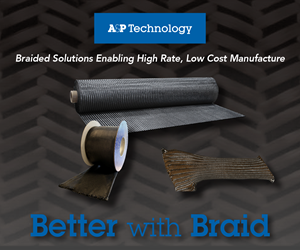Carbon fiber composites: The past can be the future
JIm Stike, of Materials Innovation Technologies – Reengineered Carbon Fibers (Fletcher, N.C.), points to progress in the reclaiming of waste and end-of-life carbon fiber.
Recycling. Repurposing. “Green” solution. Environmentally
friendly. Cradle to grave. Cradle to cradle. Zero land fill.
Until recently these descriptors and phrases have been absent from the lexicons of most composites companies.
Not that everyone has been ignoring this issue. In fact, I keep a copy of a May 2007 High-Performance Composites article on the subject of recycling carbon fiber right here on my desk as a motivator and reminder that talk is cheap, but a cost-effective solution requires hard work (see “Carbon fiber: Life beyond the landfill," under "Editor's Picks, at top right”).
Our company, Materials Innovation Technologies, started out as an advanced-materials engineering company that had a very interesting idea: Manipulate chopped fibers (1 inch/25.7 mm in length) in a slurry-molding process to produce complex-shaped preforms.
In 2005, the U.S. Department of Energy (DoE) was looking for innovative processes that could reduce the cost of manufacturing lightweight automotive components. Mass reduction equates to better fuel efficiency in cars powered by internal combustion engines or hybrid-electric power plants. In the case of battery electric vehicles, it equates to a greater driving range between charges. Automotive lightweighting was a technical topic for the DoE’s Small Business Innovation Research (SBIR) program, and my company was fortunate enough to win a Phase I award of $100,000 to demonstrate that we could cost-effectively replace a metal automotive component with one of chopped carbon fiber-reinforced polymer. Later, a North Carolina state match, an SBIR Phase II award, a Supplemental award and a Phase III Commercialization award turned our initial SBIR into $4.2 million worth of development funding and, more importantly, into three excellent automotive parts that had high potential for commercial production.
(As a side note, let me add a word of encouragement, based on our experience. Small business owners in the U.S. owe it to themselves and to their companies to learn about, understand and then participate in the federal government’s SBIR program. Yes, the paperwork can sometimes be a hassle, and yes, it is a highly competitive process. But if your company has a solution to a problem, and if your team can manage projects on time and on budget and deliver results, then I highly recommend these programs. You can begin your learning process at www.grants.gov.)
When we began our work, we focused on using virgin carbon fiber and quickly learned that glass, aramid, quartz, natural fibers (including jute, kenaf, flax and coir) and thermoplastic fibers worked equally well in our 3-DEP (three-dimensional engineered preform) process. But we soon turned to reclaimed fiber. When fiber is reclaimed from a composite material or component, it cannot be preserved in its continuous or woven form. The fiber that remains is of good quality, but in discontinuous form. It is typically chopped fiber. We started using fiber reclaimed from all a variety of carbon fiber scrap — from dry continuous fiber to wovens, uncured prepregs and cured prepregs — and we also moved into end-of-life components and reclaimed those carbon fibers and reused them. Today, recycled chopped fiber from these sources is used cost-effectively in our 3-DEP process to produce very uniform, high-quality preforms. We have taken end-of-life composite aircraft parts, well-used (some would say abused) composite hockey sticks and old carbon-fiber bicycle frames and turned them into lightweight automotive components.
Nine out of 10 times, when I ask carbon fiber producers, converters or molders what they do with their in-process scrap, the answer is, “We throw it in a dumpster and send it to the landfill.” But companies like ours are proving that recycling is viable and that reclaimed fibers can be used successfully in many applications. We now offer a better waste-disposal solution, both environmentally and commercially, to molders who use virgin fiber. We are working with numerous companies, first to keep their composite scrap out of landfills — we are approaching 1 million lb (453.6 metric tonnes) of scrap reclaimed — and more importantly, we’re helping them to close the loop and turn their waste fibers into reengineered carbon fiber composite parts. It’s time to turn carbon fiber’s past into its future.
Related Content
Watch: A practical view of sustainability in composites product development
Markus Beer of Forward Engineering addresses definitions of sustainability, how to approach sustainability goals, the role of life cycle analysis (LCA) and social, environmental and governmental driving forces. Watch his “CW Tech Days: Sustainability” presentation.
Read MorePartners recycle A350 composite production waste into adjustable-length rods for MFFD
Herone, Spiral RTC, Teijin Carbon Europe and Collins Aerospace Almere recycle A350 thermoplastic composite clips/cleats waste into rods for the all-thermoplastic composite Multifunctional Fuselage Demonstrator’s crown.
Read MoreAll-recycled, needle-punched nonwoven CFRP slashes carbon footprint of Formula 2 seat
Dallara and Tenowo collaborate to produce a race-ready Formula 2 seat using recycled carbon fiber, reducing CO2 emissions by 97.5% compared to virgin materials.
Read MoreCorebon induction heating
This sidebar to CW’s August 2024 feature article reviews this technology for more efficient composites manufacturing and why it aligns with Koridion active core molding.
Read MoreRead Next
Carbon fiber: Life Beyond the Landfill
Reclamation technologies give scrapped aerospace-grade carbon fiber new possibilities and a lower price point in nonstructural/conductive applications.
Read MoreNext-gen fan blades: Hybrid twin RTM, printed sensors, laser shock disassembly
MORPHO project demonstrates blade with 20% faster RTM cure cycle, uses AI-based monitoring for improved maintenance/life cycle management and proves laser shock disassembly for recycling.
Read MoreUltrasonic welding for in-space manufacturing of CFRTP
Agile Ultrasonics and NASA trial robotic-compatible carbon fiber-reinforced thermoplastic ultrasonic welding technology for space structures.
Read More






















